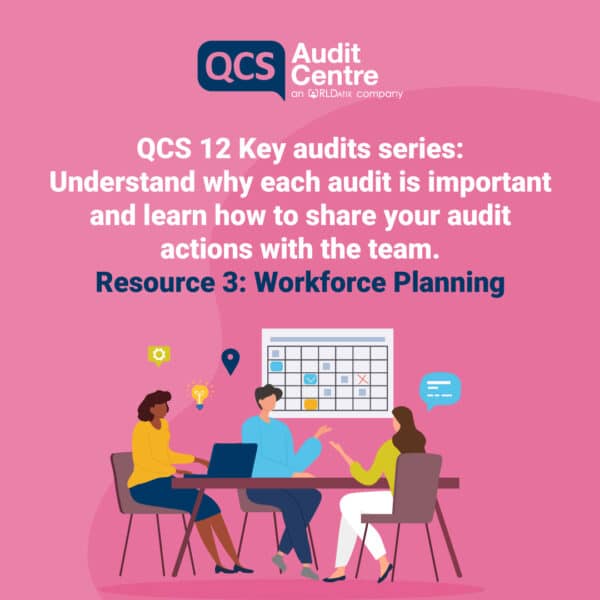Why do we need to complete audits?
To achieve good governance in your service you must demonstrate continuous quality improvement. To do this, auditing and documenting the effectiveness of the processes and systems you have in place, and taking the time to observe and document how people experience your service, is essential.
Auditing and action plans offer evidence of the great care you provide. Where improvements are needed, they allow you to demonstrate openly and clearly how you plan to make the changes required that you have identified.
Workforce planning: the case for auditing
Effective workforce planning will support your service to run smoothy and safely whilst maximising the well-being of both your staff and the people you support. Auditing the process will inform decision-making and resource allocation, as well as highlight clearly any areas for improvement.
A robust and effective workforce planning audit will explore compliance with staff training and competency assessments, as well as induction, supervision and appraisal requirements. It will also shine a light on the staff rota, ensuring that this is available in advance, shifts are filled and annual leave and sickness/absence are well managed.
It is also vital that your workforce planning audit includes consideration of staff well-being and the well-being of the people you support. This should include ensuring care needs are being met in a timely manner and satisfaction surveys are being completed regularly and acted on.
Auditing allows you to identify potential challenges or gaps in your planning and gives you the opportunity to take necessary actions to make improvements.
- Audits are vital for promoting a culture of continuous learning and improvement
- Audits support you to examine and improve existing policies, procedures, and practices
- Audits can support and identify areas that require improvements
Workforce planning auditing: achieving compliance
The workforce planning audit will enable you to provide valid, up to date evidence to the CQC that you are managing your workforce needs effectively and meeting the required regulations such as:
- Regulation 12: Safe care and treatment
- Regulation 17: Good governance
- Regulation 18: Staffing
- Regulation 19: Fit and proper persons employed
Findings: what does the workforce planning audit tell you?
Example 1:
Your workforce planning audit revealed that some staff training in moving and positioning appears to have expired.
As a provider you should:
- Review the training matrix in full to ensure that all new training certificates have been added
- Identify which staff require update/refresher training, inform them immediately and book a training session before their next shift on duty
- Staff who do not have up to date training and competence in moving and positioning should not undertake any moving and position duties until their training and competence is updated successfully
- Complete a review of your training process to understand why the gap in training has occurred, put in place a plan to ensure it does not happen again, and share the learning from the review with the whole team
Example 2:
Your workforce planning audit has highlighted that call response times have increased and the people you support sometimes appear to wait long periods for their care.
As a provider you should:
- Review the assessment needs of the people you support, have they changed/increased over time?
- Speak with staff about how they meet the needs of the people they support, are care plans up to date and do they truly reflect the needs?
- Review the numbers of staff on duty, their skills, training, experience and competence, are they providing care efficiently?
- Observe the care in your service, it should not feel rushed, it should be compassionate and dignified
- Make sure shifts are being filled as per the planned rota. How is absence/sickness being managed?
- Make sure satisfaction surveys been completed recently and review what they tell you
- Based on your findings, put a plan of action in place to improve response times, and share this with the team
- Evaluate progress regularly, taking further actions as need to ensure improvement
So, what happens next?
Effective auditing can encourage staff to have confidence in your processes and in turn foster an open and transparent culture, where staff feel comfortable raising their concerns about staffing challenges so you can work together to resolve them.
Furthermore, the regulator and people who support the service will gain confidence in your processes and be assured that your good governance systems create an environment where learning and improvement thrive, benefiting the safety and well-being of those receiving care and support.
Once you have had a chance to review your audits you can then if needed:
- Allocate resources
- Implement prevention measures
- Increase/implement/refresh staff training
- Consider environmental changes
- Consider the use of assistive devices
- Share the findings and actions with the team
Now help your team learn about the workforce planning audit by completing our QCS Resource 3: Workforce Planning Audit – Group Learning Exercise.




